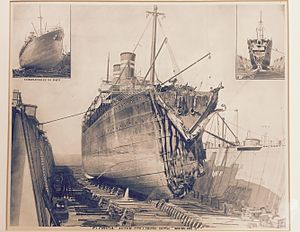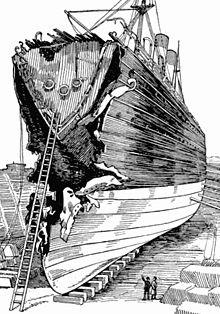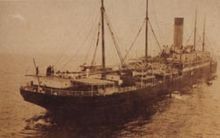SS Florida (1905)
 SS Florida after colliding with RMS Republic in 1909.
| |
| History | |
|---|---|
| Name |
|
| Namesake | |
| Owner |
|
| Port of registry | |
| Builder | Societa Esercizio Bacini |
| Yard number | 35 |
| Laid down | 1905 |
| Launched | 22 June 1905 |
| Maiden voyage | 18 September 1905 |
| Out of service | 12 December 1917 |
| Identification |
|
| Fate | Sank after colliding with SS Caprera on 12 December 1917 |
| General characteristics | |
| Type | Passenger ship |
| Tonnage | 5,018 GRT |
| Length | 116.1 metres (380 ft 11 in) |
| Beam | 14.3 metres (46 ft 11 in) |
| Installed power | Twin triple expansion engines |
| Propulsion | 2 screw propellers |
| Speed | 14 knots (26 km/h; 16 mph) |
| Capacity | 1,625 Passengers (25 1st-class & 1,600 steerage) |
| Notes | Two masts & two funnels |
SS Florida was an Italian ocean liner, built in 1905 for Lloyd Italiano, which operated between Italy and both North and South America. In 1909 she collided with, and sank, White Star Line's Republic off the American coast. Later, as Cavour with Transatlantica Italiana, she was sunk by collision with the Italian auxiliary cruiser Caprera off the Spanish Mediterranean coast on 12 December 1917, without loss of life.[1]
Construction[edit]
Florida was launched for Lloyd Italiano of Genoa, Italy at the Società Esercizio Bacini shipyard in Riva Trigoso, near Genoa, on 22 June 1905, and completed in September of that year. The ship was 116.1 metres (380 ft 11 in) long and had a beam of 14.3 metres (46 ft 11 in). She was assessed at 5,018 GRT and had a pair of triple expansion engines driving twin screw propellers. The ship could reach a maximum speed of 14 knots (26 km/h; 16 mph) and had two masts and two funnels. As built, she had the capacity to carry 25 1st-class and 1,600 steerage passengers.[2] She had a sister ship, Virginia.
Early career[edit]
For her maiden voyage she sailed from Genoa on 18 September 1905, calling also at Naples, en route to Buenos Aires. Florida's next voyage was to inaugurate Lloyd Italiano's Genoa–Palermo–New York route, which she served until 1911.[3]
RMS Republic collision[edit]

In January 1909, Florida was on her usual route from Genoa and Palermo to New York, carrying 13 first class and 826 steerage passengers alongside her crew, under the command of 29-year-old Captain Angelo Ruspini. On the morning of 23 January, Florida entered a thick fog bank while 50 miles (80 km) off the island of Nantucket, Massachusetts, and consequently reduced her speed. At 5.47 am the British outbound RMS Republic of White Star Line suddenly emerged from the fog, in the path of Florida. Both ships took evasive action, but collision could not be averted. Florida's bow struck Republic amidships on her port side at about a right angle, level with her engine room.[1] Florida's bow was crushed in at least 10 metres (32 ft 10 in), back to her collision bulkhead, killing three of her crew. Two of Republic's passengers were killed by the impact, and two more died later from their injuries.[1][4]

The ships separated and, due to her forward collision bulkhead being intact, Florida was in no danger of sinking and remained controllable. The ship stayed alongside the damaged Republic, which sent out a CQD distress signal with her newly installed Marconi wireless telegraph system, one of the first to do so. Together with the first rescue ship to arrive, United States revenue cutter Gresham, Florida took on nearly all of Republic's passengers, becoming dangerously overloaded. That evening the White Star liner Baltic arrived, having responded to the radio distress signal. All the surviving passengers, from both ships, were transferred to Baltic, while the crew of Florida covered the damaged bow with a sail and followed Baltic to New York.[2] Republic, on the other hand, could not be saved, and sank on 24 January without further loss of life. Florida was eventually assisted by two tugboats and arrived in New York on the morning of 26 January. Repairs were completed in just 24 days.[5]

Later years and sinking[edit]
Florida completed her final voyage to New York on 20 April 1911 and was sold later that year, with her sister-ship Virginia, to Società di Navigazione la Ligure Brasiliana and renamed Cavour.[3] Her new schedule brought her back to South America, first departing from Genoa on 15 January 1912 for Naples and Buenos Aires. In 1913 Hamburg America Line bought the Ligure Brasiliana business, including Cavour and Garibaldi (the former Virginia), and the following July changed its name to Transatlantica Italiana Società Anonima di Navigazione.[6]
After the outbreak of World War I, Cavour left Buenos Aires for the last time in October 1914. When Italy entered the war in May 1915, the Italian chairman of Transatlantica Italiana was able to acquire almost all of Hamburg-Amerika's shares and in 1916 resold them to a member of the Ansaldo group. It was under their service that on 12 December 1917, Cavour collided with the Italian auxiliary cruiser Caprera 2.5 nautical miles (4.6 km) off L'Ametlla de Mar, Catalonia, Spain. Cavour was lost in the incident, but all on board survived.[3][7][8]
Wreck[edit]
The current condition of the wreck is unknown, but is believed to lie 52 m (171 ft) deep.[7]
References[edit]
- ^ a b c "Columbus". theyard.info. Retrieved 15 July 2023.
- ^ a b "Florida". titanicinquiry.org. Retrieved 15 July 2023.
- ^ a b c Bonsor, Noel R. P. (1983). South Atlantic Seaway. St. Brelade, Jersey: Brookside Publications. pp. 369–372. ISBN 0-905824-06-7.
- ^ "RMS Republic (II) (+1909)". The Wrecksite. Affligem, Belgium: Adelante EBVBA. Retrieved 15 July 2023.
- ^ "SS Florida / SS Republic Collision (TBT)". martinottaway.com. 13 August 2014. Retrieved 15 July 2023.
- ^ Bonsor, Noel R. P. (1983). South Atlantic Seaway. St. Brelade, Jersey: Brookside Publications. pp. 340–343. ISBN 0-905824-06-7.
- ^ a b "Florida SS (1905~1912)". wrecksite.eu. 10 December 2010. Retrieved 15 July 2023.
- ^ "SS Cavour (+1917)". The Wrecksite. Affligem, Belgium: Adelante EBVBA. Retrieved 15 July 2023.
